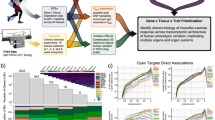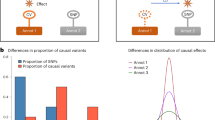Abstract
Keloid is a dermal fibroproliferative growth that results from dysfunction of the wound healing processes. Through a multistage genome-wide association study using 824 individuals with keloid (cases) and 3,205 unaffected controls in the Japanese population, we identified significant associations of keloid with four SNP loci in three chromosomal regions: 1q41, 3q22.3–23 and 15q21.3. The most significant association with keloid was observed at rs873549 (combined P = 5.89 × 10−23, odds ratio (OR) = 1.77) on chromosome 1. Associations on chromosome 3 were observed at two separate linkage disequilibrium (LD) blocks: rs1511412 in the LD block including FOXL2 with P = 2.31 × 10−13 (OR = 1.87) and rs940187 in another LD block with P = 1.80 × 10−13 (OR = 1.98). Association of rs8032158 located in NEDD4 on chromosome 15 yielded P = 5.96 × 10−13 (OR = 1.51). Our findings provide new insights into the pathophysiology of keloid formation.
This is a preview of subscription content, access via your institution
Access options
Subscribe to this journal
Receive 12 print issues and online access
$209.00 per year
only $17.42 per issue
Buy this article
- Purchase on Springer Link
- Instant access to full article PDF
Prices may be subject to local taxes which are calculated during checkout


Similar content being viewed by others
References
Marneros, A.G. & Krieg, T. Keloids–clinical diagnosis, pathogenesis, and treatment options. J. Dtsch. Dermatol. Ges. 2, 905–913 (2004).
Robles, D.T. & Berg, D. Abnormal wound healing: keloids. Clin. Dermatol. 25, 26–32 (2007).
Kelly, A.P. Keloids. Dermatol. Clin. 6, 413–424 (1988).
Marneros, A.G., Norris, J.E., Olsen, B.R. & Reichenberger, E. Clinical genetics of familial keloids. Arch. Dermatol. 137, 1429–1434 (2001).
Bayat, A., Bock, O., Mrowietz, U., Ollier, W.E. & Ferguson, M.W. Genetic susceptibility to keloid disease and transforming growth factor beta 2 polymorphisms. Br. J. Plast. Surg. 55, 283–286 (2002).
Bayat, A., Bock, O., Mrowietz, U., Ollier, W.E. & Ferguson, M.W. Genetic susceptibility to keloid disease and hypertrophic scarring: transforming growth factor beta1 common polymorphisms and plasma levels. Plast. Reconstr. Surg. 111, 535–543 discussion 544–546 (2003).
Bayat, A. et al. Genetic susceptibility to keloid disease: mutation screening of the TGFbeta3 gene. Br. J. Plast. Surg. 58, 914–921 (2005).
Brown, J.J. et al. Genetic susceptibility to keloid scarring: SMAD gene SNP frequencies in Afro-Caribbeans. Exp. Dermatol. 17, 610–613 (2008).
Marneros, A.G., Norris, J.E., Watanabe, S., Reichenberger, E. & Olsen, B.R. Genome scans provide evidence for keloid susceptibility loci on chromosomes 2q23 and 7p11. J. Invest. Dermatol. 122, 1126–1132 (2004).
Leonid, L. Prospects for whole-genome linkage disequilibrium mapping of common disease genes. Nat. Genet. 22, 139–144 (1999).
Yamaguchi-Kabata, Y. et al. Japanese population structure, based on SNP genotypes from 7003 individuals compared to other ethnic groups: effects on population-based association studies. Am. J. Hum. Genet. 83, 445–456 (2008).
Okada, Y. et al. A genome-wide association study in 19633 Japanese subjects identified LHX3-QSOX2 and IGF1 as adult height loci. Hum. Mol. Genet. 19, 2303–2312 (2010).
Ellsworth, B.S. et al. The gonadotropin releasing hormone (GnRH) receptor activating sequence (GRAS) is a composite regulatory element that interacts with multiple classes of transcription factors including Smads, AP-1 and a forkhead DNA binding protein. Mol. Cell. Endocrinol. 206, 93–111 (2003).
Pisarska, M.D., Bae, J., Klein, C. & Hsueh, A.J. Forkhead l2 is expressed in the ovary and represses the promoter activity of the steroidogenic acute regulatory gene. Endocrinology 145, 3424–3433 (2004).
Crisponi, L. et al. The putative forkhead transcription factor FOXL2 is mutated in blepharophimosis/ptosis/epicanthus inversus syndrome. Nat. Genet. 27, 159–166 (2001).
Moustafa, M.F., Abdel-Fattah, M.A. & Abdel-Fattah, D.C. Presumptive evidence of the effect of pregnancy estrogens on keloid growth. Case report. Plast. Reconstr. Surg. 56, 450–453 (1975).
Chau, D. et al. Tamoxifen downregulates TGF-beta production in keloid fibroblasts. Ann. Plast. Surg. 40, 490–493 (1998).
Hu, D., Hughes, M.A. & Cherry, G.W. Topical tamoxifen–a potential therapeutic regime in treating excessive dermal scarring? Br. J. Plast. Surg. 51, 462–469 (1998).
Kumar, S. et al. cDNA cloning, expression analysis, and mapping of the mouse Nedd4 gene. Genomics 40, 435–443 (1997).
Wang, X. et al. NEDD4–1 is a proto-oncogenic ubiquitin ligase for PTEN. Cell 128, 129–139 (2007).
Vecchione, A., Marchese, A., Henry, P., Rotin, D. & Morrione, A. The Grb10/Nedd4 complex regulates ligand-induced ubiquitination and stability of the insulin-like growth factor I receptor. Mol. Cell. Biol. 23, 3363–3372 (2003).
Morén, A., Imamura, T., Miyazono, K., Heldin, C.H. & Moustakas, A. Degradation of the tumor suppressor Smad4 by WW and HECT domain ubiquitin ligases. J. Biol. Chem. 280, 22115–22123 (2005).
Izzi, L. & Attisano, L. Ubiquitin-dependent regulation of TGFbeta signaling in cancer. Neoplasia 8, 677–688 (2006).
Izzi, L. & Attisano, L. Regulation of the TGFbeta signalling pathway by ubiquitin-mediated degradation. Oncogene 23, 2071–2078 (2004).
Bettinger, D.A., Yager, D.R., Diegelmann, R.F. & Cohen, I.K. The effect of TGF-beta on keloid fibroblast proliferation and collagen synthesis. Plast. Reconstr. Surg. 98, 827–833 (1996).
Nakamura, Y. The BioBank Japan project. Clin. Adv. Hematol. Oncol. 5, 696–697 (2007).
Kelly, A.P. Update on the management of keloids. Semin. Cutan. Med. Surg. 28, 71–76 (2009).
Saito, A. & Kamatani, N. Strategies for genome-wide association studies: optimization of study designs by the stepwise focusing method. J. Hum. Genet. 47, 360–365 (2002).
Ohnishi, Y. et al. A high-throughput SNP typing system for genome-wide association studies. J. Hum. Genet. 46, 471–477 (2001).
de Bakker, P.I. et al. Efficiency and power in genetic association studies. Nat. Genet. 37, 1217–1223 (2005).
Barrett, J.C., Fry, B., Maller, J. & Daly, M.J. Haploview: analysis and visualization of LD and haplotype maps. Bioinformatics 21, 263–265 (2005).
Purcell, S. et al. PLINK: a tool set for whole-genome association and population-based linkage analyses. Am. J. Hum. Genet. 81, 559–575 (2007).
Acknowledgements
We express our heartfelt gratitude to all the subjects who participated in this study and the members of the Rotary Club of Osaka-Midosuji District 2660 Rotary International in Japan for supporting our study. We would like to thank S.-K. Low for her assistance in the statistical analysis. We also thank the technical staff of the Laboratory for Genotyping Development in RIKEN. We would like to express our gratefulness to T. Tamamoto and K. Matsuda for their outstanding technical assistance. This work was conducted as a part of the BioBank Japan Project that was supported by the Ministry of Education, Culture, Sports, Science and Technology of the Japanese government.
Author information
Authors and Affiliations
Contributions
Y.N. conceived the study. Y.N., H.Z., M.N., S.C. and M.K. designed the study. M.N., N.H. and M.K. performed the genotyping. M.N., A.T., N.K., T.K. and T.T. performed the data analyses. Y.N., H.Z. and M.K. managed DNA samples belonging to BioBank Japan. M.N. summarized the results. M.N., H.Z., M.K. and Y.N. wrote the manuscript. Y.N. obtained funding for the study.
Corresponding author
Ethics declarations
Competing interests
The authors declare no competing financial interests.
Supplementary information
Supplementary Text and Figures
Supplementary Tables 1 and 2 and Supplementary Figure 1 (PDF 361 kb)
Rights and permissions
About this article
Cite this article
Nakashima, M., Chung, S., Takahashi, A. et al. A genome-wide association study identifies four susceptibility loci for keloid in the Japanese population. Nat Genet 42, 768–771 (2010). https://doi.org/10.1038/ng.645
Received:
Accepted:
Published:
Issue Date:
DOI: https://doi.org/10.1038/ng.645
This article is cited by
-
Post-operative KEloids iRradiation (POKER): does the surgery/high-dose interventional radiotherapy association make a winning hand?
La radiologia medica (2024)
-
Characterization of the skin keloid microenvironment
Cell Communication and Signaling (2023)
-
Postoperative Scar Management Protocol for Asian Patients
Aesthetic Plastic Surgery (2023)
-
Hypertrophic Scars and Keloids: Advances in Treatment and Review of Established Therapies
American Journal of Clinical Dermatology (2023)
-
Maternal iron status in early pregnancy and DNA methylation in offspring: an epigenome-wide meta-analysis
Clinical Epigenetics (2022)



